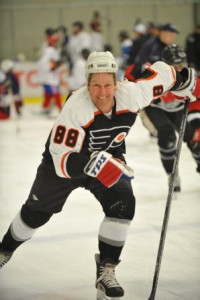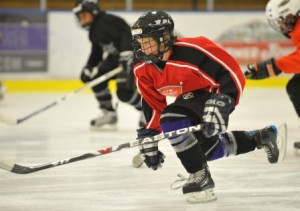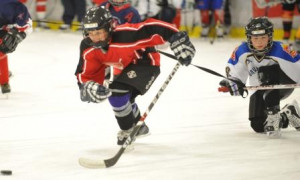Eligibility Questions
Who are your Power Skating Programs for?
Our Power Skating Programs are for All Skill Levels, Boys and Girls, Mite to Pro, Youth Hockey to Adult!!! Our students compete with themselves to improve their fundamentals and foundations for attaining better hockey skills…and that’s the kind of competition we like!
We have the Step-By-Step Program for HOW TO Skate Faster!


Is my Skater Too Skilled or, vice versa, Not Skilled enough to attend?
We take ALL levels of Hockey Players, and we break the Players up by skill levels on the ice, giving the more advanced players harder drills and concepts while the newer players get drills and skills designed for them as well… However, it should be pointed out that if we had some of our NHL Students on the ice at the same time the kids are out there…
The NHL’ers would be getting the EXACT SAME TECHNIQUES AND PRINCIPLES….
SO IT WORKS FOR EVERYBODY!
My player is a Mite/U8…can they participate in the Camps?
It is recommended that all participants in our program should already by playing ice hockey in full ice hockey gear and already on team.
Also, the player should already go be able to skate backwards and be able to stop on ice skates (on one side at least), and have a good attention span.
Youth Hockey Players of ALL AGES Have Fun…
And Do Great at Our Camps!
Which Group should I sign my Player up for?
We use age as predetermining factor for how we split up the groups and generally, it works out that we stick fairly close to the original group split…HOWEVER, the way we break up the groups by age is simply a guide, and if you have a more advanced 2nd year Squirt, for example, we have no problem with them skating in the Pee Wee and Up group…We leave it to you to help us determine what is best.
My skater is a Travel Level Player, is your Program right for them?
I’m an Adult Hockey Player, will I feel out of place skating in the Pee Wee & Up Group?
We have tremendous experience and success with mixing adult players in with the older youth hockey players.
Our Students are concentrating so hard on their own strengths and weakness and the techniques we are teaching, that they will not have time to notice who is in the camp with them.
Note: We do recommend that you make an attempt to get a teammate or friend to come along with you (or check with us in the office to see if there are other players that are around your age and/or size) so that you have someone to pair up with when necessary.

Are Goalies welcome at your Programs?
Absolutely!!… Goalies are welcome and encouraged to wear full goalie gear if that’s what they prefer.
Please note that we will not be taking shots at the Goalies for the most part (no nets), but we do give them goalie specific skating exercises whenever possible! Most of the time they are skating with the out skaters and working on their fundamentals too!
Curriculum Questions
How can we reach Robby Glantz Power Skating?
Please contact our Office Manager, Donna at anytime, +1-818-776-9045 or Email [email protected]
To reach Robby directly, please email him at [email protected]
Thanks for your interest in our Program… and we look forward to seeing all of you at the rink soon!!
What Skating Skills are stressed at your Power Skating Programs?
We try to cover all aspects of skating used in ice hockey, including:
- Forward & Backward Stride
- Crossovers
- Quick Starts & Stops
- Speed with Pucks
- Wide Legs Puck Protection Moves
- Turning with Acceleration
- Transitions
- Fakes
- And So Much More
…And rather than just telling you what to do… we ALWAYS STRESS HOW TO DO IT and WHY IT’S IMPORTANT FOR YOUR SKILL DEVELOPMENT!

Do you use Pucks at your Power Skating Programs?
Absolutely!!!
AT ALL OF OUR POWER SKATING PROGRAMS, we teach how to skate faster with and without the puck…
And we even show the players the EXACT location where the puck should be placed in relation to the body in order to gain maximum stride efficiency, puck protection and speed.

Do you teach Stickhandling skills at your Programs?
Yes!!
We have been teaching Stickhandling and Puck skills at All of our Programs for Years… and we continue to do so at every Power Skating Program.
And as always, we teach HOW TO DO IT, with fundamentals broken down, STEP-BY-STEP, in an easy to understand and easy to retain format!

What are the Bungie Cords and Resistance Training Devices?
Since everybody involved with Robby Glantz Int’l Power Skating is a former or current Ice Hockey player, we like to think of ourselves as stride and speed coaches!
Our Program being designed specifically for the Ice Hockey Player…and we have found that a couple of the great methods for getting more speed are training methods that we have adapted from the Track and Field Coaches…

One is that we use Bungie Cords to pull players faster than they can go on their own, and yet, they still have to keep their legs moving with the Cord…This is called Overspeed Training. You truly have to see and experience our Overspeed Training, ALL the players (including the Pros) love the Bungies!

Another is the use Resistance Leashes which help build up the leg & core muscles and improve posture, edge control, technique and power…This is called Underspeed Training!
How many Students are in a Class?
Our group size goal is to have around 36 skaters on the ice per group. (Please Note: Can vary by a few player… and our 1 group programs can have more skaters).
Skating Related Questions
How tight should the skates be tied?
It’s a very simple answer… TIGHT!
And you or your skater should be in as high quality of a boot as you can afford… preferably CCM 🙂
Ankle bending impedes all facets of skating: Especially stopping, lateral moves, transitions and backwards!

How important is the quality of the Skate?
The quality of the boot is vital!
Parents, if possible, please only invest in the top of the line, best skates available (even though they cost more) because the support that they give to even the youngest of skaters is so important for development, balance and most importantly, confidence.
What can you tell me about skate sharpening and rockering?
Skate Sharpening: This is an individual matter…. For example, I have coached pro players who will go games without sharpening their skates and likewise, I have coached players who sharpen them between periods…
With that said, there are a couple of rules that you may want to follow… If you or your child is having trouble with stopping… then the skates are probably too sharp. A skate that is too sharp can certainly hurt a players ability to stop because before you stop, you need to slide and that is easier with a duller skate.
Likewise, if you or your child is sliding all over the ice or your skates are coming out from under you when you turn, etc. than it is probable that you need your skates sharpened (by the way, we find that the turning problems, while it is easy to blame the skates, generally comes from a technique problem in the turn).
I also am asked frequently about what hollow to get on the skate… unfortunately, there is no universal answer except to say that you should try a couple of different hollows, see which you like the best and then stick with it… and also try to stay with the person at the hockey shop who does the sharpening that you like the best.
Rockering: Many feel that rockering the skate (rounding the blade so that less blade touches the ice) canhelp with turning, quickness, etc. and that rockering the skate towards the front or the back of the blade is also important for the same reasons. Again, this is an individual preference and many players and hockey shop pros rely on it.
The positives may be a little more quickness, agility and possibly, quicker turns, etc…. while the downsides are, the less blade touching the ice, the less thrust into the ice that blade will provide, and this can hurt top speed and the ability to glide to cover distance (speedskaters use longer blades simply to go faster, for example)… but again find what works for you and then stick with it.


